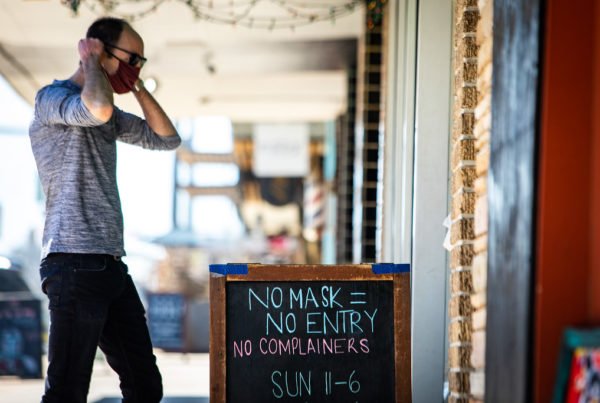Teachers and learning advocates in Texas have long called for greater representation of Asian Americans in classrooms. Now, the conversation is being reopened after the recent rise in Anti-Asian attacks and hate crimes.
Educators across the country say bottom line: there’s not enough Asian American history covered in classrooms.
So, we spoke to teachers about what Texas students are missing out on when it comes to Asian American history. Here’s what they had to say:
1. Diversity
Dr. Madeline Hsu, a history professor at the University of Texas, said different kinds of Asian Americans often get grouped together. People of Chinese, Korean and Japanese descent tend to be discussed the most. Meanwhile, people from countries like India, Nepal, or Laos are often overlooked.
Hsu said it’s about asking people “to be willing to consider the complexity that is included in the census category [Asian American].”
She said very little is taught about regions like South and Southeast Asia. However, Texas has large populations of Vietnamese, Indian and Filipino residents who have descendants from those regions.
2. Humanity And Complexity
Dr. Hsu said the way Asian Americans are talked about is often dehumanizing, focusing more on their contributions than who they are as people.
“We feel a need to portray them as being deserving, that they sort of work hard and add to the United States, which many immigrants certainly do,” she said. “But also just to see them as human beings, and to see sort of the richness of experiences and cultures.”
Mohit Mehta is a former elementary school teacher in Austin who worked with predominantly bilingual Black and Latino students. Now, he’s pursuing a PhD in teaching at the University of Texas.
He said many of his students are exposed to Asian American culture through food or entertainment like anime or K-Pop. Mehta says educators should teach history to help students appreciate the people and cultures that have given rise to these popular products.
3. Key Figures
Teachers and learning advocates say key Asian American historical figures are missing from Texas classrooms. While textbooks may reference Martin Luther King Jr., Cesar Chavez or Elizabeth Cady Stanton, notable Asian American civil rights activists and leaders aren’t mentioned.
Here are some people that experts would like to see in classroom instruction and textbooks:
- Vincent Chin: A Chinese American man from Detroit who was murdered in 1982 by two white men. His killing ignited protests and reinvigorated the Asian American civil rights movement.
- Fred Korematsu: Civil rights activist who protested against the internment of Japanese Americans during World War II.
- Yuri Kochiyama: A lifelong activist who advocated for Japanese American internees to receive reparations and allied with Malcolm X, joining his organization the Organization for Afro-American Unity. She’s famous for a Life photo that depicts her holding Malcolm X as he lay dying.
- Grace Lee Boggs: An advocate for civil and labor rights, Boggs was deeply involved in Detroit’s Black Power movement and Asian American activism.
- Wong Kim Ark: He was a Chinese American man from San Francisco whose landmark Supreme Court case, the United States vs. Wong Kim Ark, established the precedent of birthright citizenship.
4. Important Events And Themes
Educators say the Chinese Exclusion Act, Chinese Transcontinental Railroad workers, Japanese internment and the U.S. acquisition of Pacific island territories are topics covered in Texas classrooms — and that’s about it.
Hsu said students should learn more about immigration policy: how laws were developed, citizenship restrictions and the ways that legal precedents can be traced to discrimination today.
“We need to understand Asian American history because it actually pertains to the United States broadly as a nation of immigrants,” she said.
Sarah Soonling Heng Blackburn is a teacher educator with the Southern Poverty Law Center’s Learning For Justice program. She said educators should focus on explaining not just “Asian” events, but Asian Americans’ role in history, such as their involvement in the civil rights movement or intersectional struggles with fellow minorities.
“We’re not getting the side of the activism, our role in historic civil rights and social justice movements, which is contributing to another myth of Asian American passivity or the idea that we haven’t shown up or we don’t care about justice.”
5. Modern-Day Connection
While more people are paying attention to Asian American issues, Blackburn said educators can use history to show the discrimination and violence towards Asian Americans is part of a long legacy in the U.S.
“The most successful things I’m seeing are educators who are really helping students see that this is not new,” she said. “They’ve [hate crimes and discrimination] kind of been part of the Asian experience in this country from the jump.”
The Atlanta killings in March have also sparked a conversation about how the fetishizing, objectifying, and sexualization of Asian American women makes them especially vulnerable to violence.
Hsu said the historical context for the hypersexualization of Asian women must be taught to students. Experts say the U.S. military’s presence in Southeast Asia during World War II, the Korean War and the Vietnam War spiked demand for Asian sex workers and contributed to harmful perceptions of Asian women.
Resources For Educators And Parents:
Asian Americans PBS Documentary Series
Fred T. Korematsu Institute Lesson Plans
Smithsonian Asian Pacific American Center Resources
Learning For Justice “After Atlanta: Teaching About Asian American Identity and History”
Got a tip? Email Elizabeth Myong at Emyong@KERA.org. You can follow Elizabeth on Twitter @Elizabeth_Myong or Sriya @SriyaReddy23.















